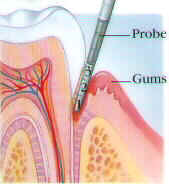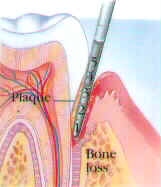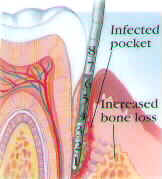|
|
|
|
|
| |
Quality general dental care with an emphasis on natural esthetics, form and function. Experience with complex restorative, prosthetic and implant treatment.
----------------------------------------------------------------------------------------
PERIODONTAL (GUM) DISEASE: TAKING CARE OF YOUR TEETH AND GUMS.
Periodontal disease, also known as gum disease is a bacterial infection of the gum tissue and bone around teeth. This process can also occur around dental implants. If left untreated the inflammation in the gum tissue spreads to the bone supporting the teeth and the teeth or implants may be lost. Forty percent or more of adults have some level of gum disease that if left untreated will cause them to lose their teeth.
Several types of Periodontal disease occur. Often painless, the disease process may progress slowly over many years or rapidly over a short period of time. Regular dental check-ups including a periodontal exam can detect this process before teeth are lost.
What causes Periodontal Disease?
The mouth contains large numbers of bacteria which are normal inhabitants of our bodies. Some of these bacteria in the precence of food particals forms a sticky film called plaque. This film harbors the bacteria and coats the teeth. The bacteria produce toxins which can irritate the gum tissue causing inflammation. This may be noticed as bleeding during brushing or spontaneously. Bleeding is a sign of a disease process and should not be concidered normal. Unfortunatly, many people have come to accept bleeding as a normal occurance in their mouths. We would be alarmed if each time we brushed our hair we saw small amounts of blood on the hair brush, and the mouth is no different.
Brushing at least twice daily and flossing help remove the plaque and its associated bacteria. Although, the bacteria quickly builds back up the sticky plaque is not present for it to adhere to. Professional cleanings are still needed to reach the areas that you are unable to brush and floss. These dental visits also allow detection of problems when they are small and are thus less costly and painful.
Plaque that is not removed hardens into tartar (also known as calculus). Tartar begins forming in-between the teeth and then spreads into the more visible areas. This hard substance can only be removed by the dentist or hygienist using special intruments as brushing or flossing can not remove it.
Warning Signs of Gum Disease!
Gums that bleed when brushing or spontaneously
Red, swollen or tender gums.
Gum tissue that has receeded away from the teeth exposing some of the root surface.
Persistant bad breath or taste.
Pus between the teeth or at the gum line when the tissue is pressed.
Teeth feel loose or are seperating leaving gaps between them.
Changes in how the top teeth and bottom teeth feel together when you bite.
Changes in how a partial denture fits.
It is possible to have periodontal disease and not see any of the warning signs. Periodontal disease is the silent killer of teeth. That is why regular check-ups are important.
Stages (Types) of Periodontal Disease
Surrounding each tooth or implant is a "V" shaped groove called the sulcus. The sulcus is measured in millimeters and readings of 3 millimeters or less is concidered healthy. With periodontal disease the sulcus develops into a pocket and deeper readings can be detected. Generally, the deeper the pockets the more severe the periodotnal disease.
Gingivitis is a mild, often reversible form of periodontal disease. As the bacteria in the plaque accummulate the bacterial toxin levels increase and irritate the gums, making them red, tender, swollen and likely to bleed. If left untreated this may progress into Periodontitis. Treatment to eliminate gingivitis consists of a through cleaning to remove all tartar and plaque between the teeth and under the gum line and better home care.
When gingivitis is left untreated the inflammation in the sift tissue can spread to the bone supporting the teeth. This is referred to as Periodontitis whenthe toxins destroy the boney support. As the pocket deepens the gum tissue detachs from the teeth. Exposed roots become more susceptible to decay and may be cold, sweet or air sensitive. Tartar that forms below the gum line inhibits and prevents reattachment of the gumtisuue to the teeth. Periodontitis is divided into three groups depending on how much bone has been lost. In mild periodontitis, x-rays will show slight bone loss but the teeth remain firm. When this progresses further moderate periodontitis results and this is identified by significant bone loss, loosening of the teeth, possible drifting of the teeth and further root exposure. Advanced periodontitis can be identified when the teeth are very loose and the x-rays reveal little bone to support the teeth.
Checking for Periodontal Disease
During your check-up an instrument called a periodontal probe is used to measure the depth of the sulcus or pocket around each tooth. The probe is a blunt instrument with millimeter markings along its length. Readings of 3 millimeters or less is healthy, a reading of 4 millimeters usually indicates gingivitis and higher readings will identify periodontitis. X-rays of the teeth will help identify bone loss and detect other problems not visible to the eye. With todays high speed x-ray film, exposure is very minimal and there is very little risk of problems from having x-rays taken of the teeth.
Gingivitis

Moderate Periodontities

Advanced Periodontities

Implant Cosmetic Dental Center™
----------------------------------------------------------------------------------------
Dr. Gregori M. Kurtzman is an international lecturer, selected as one of the top 100 dental speakers since 2006 by Dentistry Today, author of over 200 professional articles, a consultant to multiple dental manufacturers for product evaluation, development and research, he provides general dental care in suburban Maryland since 1986.
|
|
|
|
|
|
|
|
|